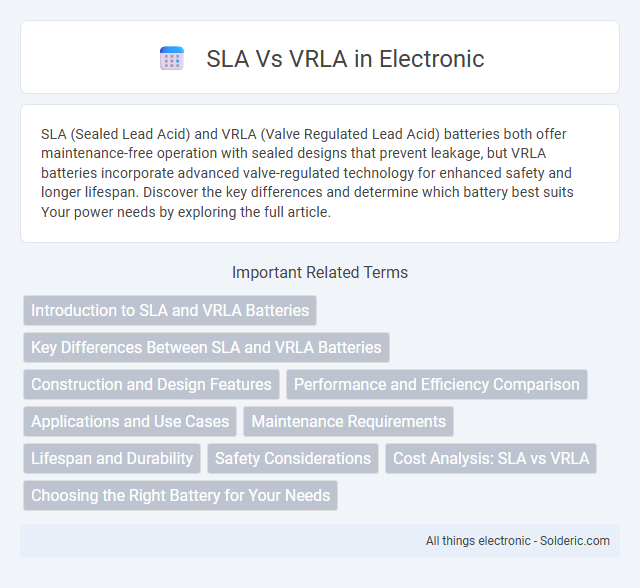SLA (Sealed Lead Acid) and VRLA (Valve Regulated Lead Acid) batteries both offer maintenance-free operation with sealed designs that prevent leakage, but VRLA batteries incorporate advanced valve-regulated technology for enhanced safety and longer lifespan. Discover the key differences and determine which battery best suits Your power needs by exploring the full article.
Comparison Table
| Feature | SLA Battery | VRLA Battery |
|---|---|---|
| Full Form | Sealed Lead Acid | Valve-Regulated Lead Acid |
| Construction | Sealed, maintenance-free with immobilized electrolyte | Sealed, uses pressure relief valve to regulate gas |
| Maintenance | Maintenance-free | Maintenance-free |
| Electrolyte | Gel or absorbed glass mat (AGM) | Gel or AGM |
| Gas Release | Minimal, vents only under extreme conditions | Valve regulates gas release to prevent explosions |
| Applications | UPS, emergency lighting, mobility scooters | UPS, telecom, solar energy storage |
| Lifespan | 3-5 years typical | 3-5 years typical, depending on usage |
| Cost | Generally lower | Higher due to advanced design |
Introduction to SLA and VRLA Batteries
Sealed Lead Acid (SLA) batteries and Valve Regulated Lead Acid (VRLA) batteries are widely used energy storage solutions known for maintenance-free operation and spill-proof design. SLA batteries typically refer to the category of lead-acid batteries with sealed construction, while VRLA batteries are a specific type of SLA that features pressure release valves to regulate internal gases during charging. Both battery types offer reliable power backup, deep cycle capabilities, and safety advantages for applications ranging from uninterruptible power supplies (UPS) to emergency lighting and automotive systems.
Key Differences Between SLA and VRLA Batteries
SLA (Sealed Lead Acid) batteries and VRLA (Valve Regulated Lead Acid) batteries primarily differ in their construction and maintenance requirements, with VRLA batteries featuring a valve to release gases safely, making them maintenance-free. SLA batteries often require periodic checking of electrolyte levels, whereas VRLA batteries are sealed and use recombination technology to prevent leakage and minimize gas emissions. The key distinctions impact their applications, where VRLA batteries are preferred for portability and safety, and SLA batteries are commonly used in stationary backup power systems.
Construction and Design Features
SLA (Sealed Lead Acid) batteries feature a robust sealed construction with absorbent glass mat (AGM) technology, preventing acid spillage and enabling maintenance-free operation. VRLA (Valve-Regulated Lead Acid) batteries incorporate a pressure relief valve system that controls gas release, enhancing safety and reliability during charging cycles. Your choice between SLA and VRLA depends on specific design needs such as durability, maintenance requirements, and application safety standards.
Performance and Efficiency Comparison
SLA (Sealed Lead Acid) batteries typically offer lower performance and efficiency compared to VRLA (Valve-Regulated Lead Acid) batteries due to slower charge acceptance and higher internal resistance. VRLA batteries, incorporating advanced valve-regulated technology, provide improved charge efficiency, reduced maintenance, and longer service life, making them ideal for high-demand applications. Your choice of battery impacts system reliability, with VRLA often preferred for optimized energy storage and consistent power delivery.
Applications and Use Cases
SLA (Sealed Lead Acid) batteries are widely used in backup power for UPS systems, emergency lighting, and wheelchairs due to their reliable, maintenance-free operation and moderate energy density. VRLA (Valve Regulated Lead Acid) batteries find applications in telecommunications, solar energy storage, and electric vehicles, offering enhanced safety with spill-proof design and better deep-cycle performance. Both battery types support stationary and portable power needs, but VRLA batteries are preferred where vibration resistance and longer cycle life are critical.
Maintenance Requirements
SLA (Sealed Lead Acid) batteries require minimal maintenance due to their sealed design, preventing electrolyte loss and reducing the need for regular water refilling. VRLA (Valve-Regulated Lead Acid) batteries, a subset of SLA, feature a valve that regulates internal gas pressure, further minimizing maintenance by eliminating the need for electrolyte checks and additions. Both battery types are designed for leak-proof operation, but VRLA batteries provide enhanced maintenance-free performance in demanding applications such as UPS systems, telecom, and renewable energy storage.
Lifespan and Durability
Sealed Lead Acid (SLA) batteries typically offer a lifespan of 3 to 5 years, with moderate durability suited for backup power and low-drain applications. Valve-Regulated Lead Acid (VRLA) batteries, a subset of SLA, provide enhanced lifespan prospects, often reaching up to 7 years due to improved valve regulation and recombination technology that minimizes water loss. VRLA batteries also boast greater durability under deep cycle conditions, making them ideal for renewable energy systems and frequent discharge scenarios.
Safety Considerations
SLA (Sealed Lead Acid) and VRLA (Valve-Regulated Lead Acid) batteries both offer enhanced safety features due to their sealed design, which prevents acid leaks and reduces the risk of spills. VRLA batteries, including AGM and gel types, incorporate pressure-relief valves that minimize gas buildup, enhancing operational safety in confined or sensitive environments. When managing Your battery storage or usage, selecting VRLA batteries can further improve safety by limiting hazardous gas emissions and maintenance risks.
Cost Analysis: SLA vs VRLA
SLA (Sealed Lead Acid) batteries generally have a lower upfront cost compared to VRLA (Valve Regulated Lead Acid) batteries, but VRLA offers longer lifespan and reduced maintenance expenses, which can lead to better long-term savings. Your choice between SLA and VRLA should consider total cost of ownership including factors such as recharge cycles, self-discharge rates, and application-specific requirements. Evaluating both initial investment and operational costs is crucial to determining the most cost-effective solution.
Choosing the Right Battery for Your Needs
Selecting between SLA (Sealed Lead Acid) and VRLA (Valve Regulated Lead Acid) batteries depends on your specific application needs, such as maintenance preferences and environmental conditions. VRLA batteries offer maintenance-free operation and better safety due to their sealed design, making them ideal for indoor use and confined spaces. SLA batteries provide a cost-effective option with reliable performance but may require regular maintenance, so consider your usage scenario to choose the right battery for your needs.
SLA vs VRLA Infographic

 solderic.com
solderic.com